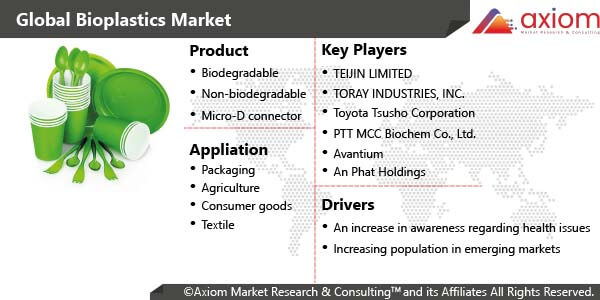Bio-plastics are replacing plastics originated from polymers. Bio-plastics are now being manufactured from biomass sources such as vegetable oils (hemp oil, soybean oil) and certain starches (corn starch, sweet potato). Bio-plastics are also known as biodegradable plastic, these are material returns to its natural state when buried in the ground. The global bio-plastics market is segmented into type, application and region. By type, the market is segmented into biodegradable and non-biodegradable plastic. The biodegradable type is further categorized into Poly lactic acid (PLA), Polyhydroxyalkanoates (PHA), Starch blends, Polyesters (PBAT & PBS), and Cellulose Acetate. The non-biodegradable plastic market segment is divided into Epoxies, Polyurethanes and Polyethylene Terephthalate. Amongst the non-biodegradable plastics, the PET (Polyethylene Terephthalate) accounted for the largest market share in 2017 and it is estimated to remain the largest market segment during the forecast period due to its similarity to traditional plastics in terms of properties hence it has large demand from the various application industries. The bio-plastics finds major applications in packaging, agriculture and horticulture, automotive, electronics, building and construction, energy storage, food service disposables and 3D printing.
Electronics are further classified into HVAC and refrigeration. The packaging segment is widely classified into flexible and rigid types of packaging. Food and beverage disposable market segment is anticipated to grow at a higher CAGR during the forecast period due to large demand of eco-friendly packaging solutions. There is high rate adoption of bio-plastics in rigid packaging is expected to continue in bottles, cups, cans, corrugated cases, and boxes. Geographically, the bio-plastics market is studied across the countries of key regions such as North America, Europe, Asia Pacific, Latin America, and Middle East & Africa. Europe is estimated to be the largest consumer of biodegradable plastics holding largest share in the global market owing to strict implementation of environmental regulations which prohibits the use of petroleum-based plastics. This trend is anticipated to significantly drive the growth of the bio-plastics market in Europe.
Growing concern for environmental conservation, consumer shift towards organic and environment-friendly alternatives as compared to the petroleum-based products and raising focus of the government and regulatory authorities are some key factors that are driving the global market. However, increasing raw materials cost coupled with surging dependence on petroleum-based bio-plastics are hindering the market growth. The key competitors of the bio-plastics market include BASF SE, Biome Technologies Plc., Braskem S.A., Corbion Purac, FKuR Kunststoff GmbH, Indorama Ventures Public Company Limited., Innovia Films, Natureworks LLC., Novamont S.p.A, SECOS Group Ltd. (Cardia Bioplastics), Toray Industries Inc., Evonik Industries, Arkema, Cardia Bioplastics, RTP Company, Techno polymer Co. Ltd., E. I. du Pont de Nemours and Company and among others.











